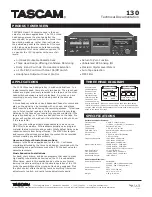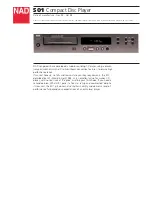
Chapter 2
Getting Started — Connecting
ENGLISH - 23
Connecting
Before connecting
f
Before connecting, carefully read the operating instructions of the devices to be connected.
f
When connecting to an external device, such as a video input/output device or a computer, use the power cord supplied for each of the
devices.
f
If cables necessary for connection are not supplied with each external devices as accessories or not available as an option, use a
commercially-available shielded cable according to the input and output terminals of the external devices to be connected.
f
Turn off the power of all devices before connecting cables.
f
Take note of the following points before connecting the cables. Failure to do so may result in malfunctions.
g
Before connecting a cable to the device, displays (projector or flat panel display), or external devices such as a video player, touch any
nearby metallic objects to eliminate static electricity from your body.
g
Do not use unnecessarily long cables when connecting the device and the displays (projector or flat panel display). Longer the cable is,
easier to be influenced by a noise. Since using a cable while it is wound makes it act like an antenna, it is more susceptible to noise.
g
When connecting a cable, insert it to the connecting terminals of the device perpendicularly, connecting to GND first.
f
Video signals containing too much jitter may cause the images on the screen to randomly wobble or wafture. In this case, a time base
corrector (TBC) must be connected.
f
Some computer models are not compatible with the device.
f
Use a cable compensator when you connect external devices such as a video player to the device using long cables. Otherwise, the device
may not display the image properly.
f
Signals that can be input to the device are digital, analog RGB (synchronization signals at TTL level), YC
B
C
R
/YP
B
P
R
, S-Video (Y/C), and
video (CV) signals. Signals that can be output from the device are digital, analog RGB (synchronization signals at TTL level), and YC
B
C
R
/
YP
B
P
R
signals. To do this, you will need to install the corresponding interface board in the device.
f
Prepare a commercially available conversion adaptor as necessary.
f
Refer to “Compatible signals” (
x
page 66) for the types of video input and output signals that can be used with the device.
<DVI-U INPUT> terminal pin assignments and signal names
Outside view
Pin No.
Signal name
Pin No.
Signal name
C4
C1
C3
C2
C5
(9)
(1)
(8)
(17)
(24)
(16)
(1)
T.M.D.S data 2-
(16)
Hot plug detection
(2)
T.M.D.S data 2+
(17)
T.M.D.S data 0-
(3)
T.M.D.S data 2 shield
(18)
T.M.D.S data 0+
(4)
―
(19)
T.M.D.S data 0 shield
(5)
―
(20)
―
(6)
DDC clock
(21)
―
(7)
DDC data
(22)
T.M.D.S clock shield
(8)
Analog VERT.SYNC
(23)
T.M.D.S clock+
(9)
T.M.D.S data 1-
(24)
T.M.D.S clock-
(10)
T.M.D.S data 1+
C1
Analog R, R, C
R
/P
R
, C, —
(11)
T.M.D.S data 1 shield
C2
Analog G, G SYNC, Y, —, CV
(12)
―
C3
Analog B, B, C
B
/P
B
, Y, —
(13)
―
C4
Analog HORI.SYNC
(14)
+5 V
C5
Analog GND
(15)
GND
















































